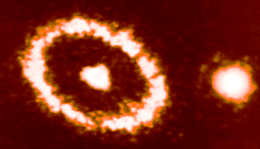

SEEING STARS:
Visualization in astronomy
IN 1987, light particles from a supernova explosion 160,000 years ago triggered telescopes
throughout the southern hemisphere. The most spectacular explosion since the time of Kepler,
it was so powerful that in the first 10 seconds the energy released was more than 100 times
greater than that emitted by the sun throughout its 10 billion years of life. The photons that
arrived on Earth got their name and activities in the papers, but other photons from the explosion
went off into space never to be seen or heard from again.
 Until now. Columbia astronomer Arlin Crotts and
graduate student Jun Xu are giving the space photons a second chance to arrive. Employing these
photons as an interstellar radar probe, Crotts and Xu for the past six years have been monitoring
the faint light echoes reflected from photons' collisions with particles of interstellar dust.
Until now. Columbia astronomer Arlin Crotts and
graduate student Jun Xu are giving the space photons a second chance to arrive. Employing these
photons as an interstellar radar probe, Crotts and Xu for the past six years have been monitoring
the faint light echoes reflected from photons' collisions with particles of interstellar dust.
Using a mathematical model with visualization techniques, the astronomers have created the first 3-D map of a substantial part of our galaxy and already have revealed phenomena that may shed a new light on stellar evolution. The major finding is the presence in the large Magellanic cloud of two large circular gas shells embracing a giant super bubble 2,000 light years in diameter. Inside are numerous hot young stars creating heated, X-ray-emitting gas. Recent Hubble Space Telescope photographs have revealed the birth of new stars in the galaxy.
Although the space telescope has received considerable attention, Dr. David Helfand, chairman of the Department of Astronomy and Astrophysics, says ground-based astronomy is far from dead. It may be undergoing a renaissance due to such technological advances as adaptive optics, a method that compensates for the loss of resolution due to the interfering atmosphere. Light from an unusually bright star can be used as a reference to measure the atmospheric distortion. The astronomer makes corrections to the picture based on the bright object and then corrects for the faint object, too.
To find such an accommodating natural situation is difficult, so astronomers created an artificial star of their own by shooting a laser beam 90 km above the turbulence of the Earth's atmosphere, where a layer of sodium ions can re-emit this light to produce a synthetic bright star. The returned light arrives "crinkled up" visually on the detection plate, but miniature activators attached to a mirror straighten out the wave fronts. The end product is a correction of the distortion caused by the atmosphere that also produces better images of the fainter stars in the vicinity. Crotts is currently using this technology.
Columbia's astronomy department also is involved in producing large-area, high-resolution, high-sensitivity surveys of the radio sky and drawing radio maps, which can then be compared with images obtained from optical observations such as the Palomar Observatory Sky Survey. The project, using a large array of advanced radio telescopes in New Mexico, is known as FIRST (Faint Images of the Radio Sky at 20 Centimeters). "Important discoveries are made by comparing the unparalleled optical data base with data obtained by observing the skies at other wavelengths," says Dr. Helfand. Recently published results from the first year of observation have attracted considerable interest among astronomers.




